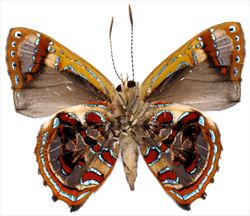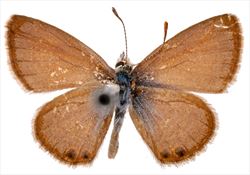OF BIOSECURITY CONCERN
Papilionoidea
Lycaenidae (blues, coppers, hairstreaks, metalmarks)
6,000 approximate described species
Cosmopolitan particularly the tropics
Fagalaceae
Narrow face; eyes close together and contiguous; base of antennae usually indenting compound eye; forewing radial vein has up to two of the five branches missing and some are stalked, one anal vein; hind wing has two anal veins and CuA2 near the tornus is usually produced into a tail or two; forelegs non functional in males, functional in females (Braby 2000, Holloway 1982).
Atlas of Living Australia. National Research Infrastructure for Australia, NCRIS. http://www.ala.org.au/
ABRS 2009. Australian Faunal Directory. Australian Biological Resources Study, Canberra. http://www.environment.gov.au/biodiversity/abrs/online-resources/fauna/afd/index.html
Butterflies and moths of North America, collecting and sharing data about Lepidoptera. National Biological Information Infrastructure (NBII) Program and the USGS Northern Prairie Wildlife Research Center. http://butterfliesofamerica.com/links.htm
CSIRO Australian National Insect Collection Database. http://anic.ento.csiro.au/database/
CSIRO Ecosystem Sciences. Australian Moths Online. http://www1.ala.org.au/gallery2/main.php
Herbison-Evans D, Crossley S. Families of Moths in Australia. http://lepidoptera.butterflyhouse.com.au/moths.html
Holloway JD, Kibby G, Djunijanti P (2001) The families of Malesian moths and butterflies, Fauna Malesiana handbook 3, The Netherlands.
iBol Terrestrial Biosurveillance, Lepidoptera barcode of life. http://www.lepbarcoding.org/
Natural History Museum, The Global Lepidoptera Names Index. http://www.nhm.ac.uk/research-curation/research/projects/lepindex/search/index.dsml
Plant Health Australia (2012) Combined High Priority Pest List from Industry Biosecurity Plans. In National Plant Biosecurity Status Report, last accessed June 2015. http://www.planthealthaustralia.com.au/biosecurity/emergency-plant-pests/pest-categorisation/categorised-pests/
Robinson GS, Ackery PR, Kitching IJ, Beccaloni GW, Hernández LM (2001) Hostplants of the moth and butterfly caterpillars of the Oriental Region, The Natural History Museum, London.
The Barcode of Life Data Systems http://www.boldsystems.org/
Common IFB (1990) In Moths of Australia, Melbourne University Press, Carlton, Victoria.
Braby MF (2000) Butterflies of Australia: Their Identification, Biology and Distribution (vol. 2). CSIRO Publishing, Victoria, Australia.
Kristensen NP (ed) (1999) Lepidoptera, Moths and Butterflies: Evolution, Systematics and Biogeography (vol. 1). Handbook of Zoology, Walter de Gruyter, Berlin.
Northern Australia Quarantine Strategy (2015) Entomology Internal Target List. Australian Government Department of Agriculture.
Operational Science Program (2015) Entomology Internal Target List. Australian Government Department of Agriculture.
Plant Health Australia (2012) Combined High Priority Pest List from Industry Biosecurity Plans. In National Plant Biosecurity Status Report, last accessed June 2015. http://www.planthealthaustralia.com.au/biosecurity/emergency-plant-pests/pest-categorisation/categorised-pests/
van Nieukerken EJ, Kaila L, Kitching IJ, Kristensen NP, Lees DC, et al. (2011) Order Lepidoptera Linnaeus, 1758. In Zhang, Z.-Q. (Ed.) Animal Biodiversity: An outline of higher level classification and survey of taxonomic richness. Order Lepidoptera Linnaeus, 1758. Zootaxa. 3148: 212–221.


